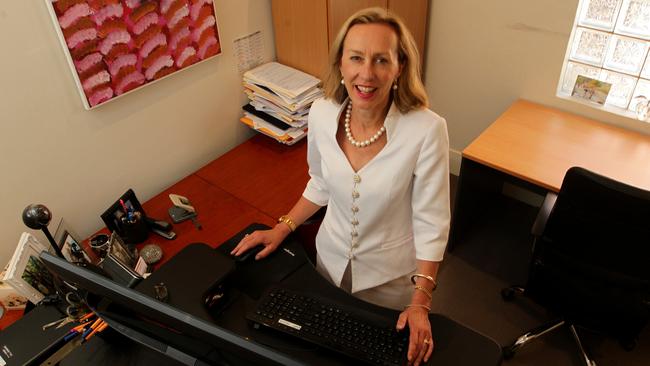Sitting down at work is the new smoking
The average worker spends an alarming 77 per cent of the day sitting down.

Welcome to the traditional white-collar working space — where thousands of Australian office-based staff sit at their desks every weekday, typing on keyboards, answering calls and looking at screens — and welcome to a world of sore backs, shoulders, necks and potential chronic disease.
According to Medibank and the Baker IDI Heart and Diabetes Institute, the average worker spends 77 per cent of their day sitting down, whether it be at their desk, eating breakfast or dinner, driving to or from work, catching public transport or watching television at night.
Healthworks founder Ken Buckley, who has been working in corporate health since the early 1980s, says the amount of time people spend seated at work is having a huge impact on health and lifestyle.
“Chronic disease is spreading through the Western world and it’s getting worse; we’re working longer hours, people are sedentary,” Buckley says.
“Everyone with a computer has email access, Skype, and all of these tools mean we’re having less need to move. We don’t get up from our desk and communicate with each other.”
Buckley says people often think of health and safety in terms of blue-collar workers — those in manufacturing plants or out on the roads — but research is increasingly showing office workers could be the unhealthiest of all. Sitting is the new smoking.
Buckley talks about hypokinetic disease, where people barely move, and says people need to move while they are at work to avoid adverse health effects, even if it means moving for two minutes every hour to fill up a water bottle.
“The Baker Institute is saying if you exercise three or four times a week that’s great, but if you’re sedentary all day at a desk and you’re not moving and the lack of movement is not having an impact on your glucose levels, the exercise you do will still not have an impact on you,” he says.
Studies show up to 45 per cent of people suffer work-related neck pain, and lower back pain is one of the most common causes of disability for working-aged people.
Chiropractors Association of Australia SA vice-president Mario Stefano says the prolonged impact of sitting all day leads to the body slowing down its processing of fats, the S-curve in the spine deteriorates, weight pressure on the back increases, necks strain forward and leg and backside muscles weaken.
He says the average head weighs 5kg, and if it strains forward just 1cm it can cause neck and ligament strain, headaches, stiffness in joints and less rotation in the spine.
“Long-term sitting for hours on end changes your postural fitness so everything else becomes difficult.” Stefano says the era of being connected to monitors may not last long, given the trend to work away from offices is increasing, and the amount of screen time people are experiencing is “devastating”.
“If your job entails you sitting all day you need to organise to get up,” he says.
“Get a drink, have a meeting not at your desk, if you drive to work park further away.”
Workers also could try sitting on a fit ball to encourage movement as balancing signals from the brain transfer to leg and core muscles, or try adjustable and standing desks.
While Stefano has used a ball in his office instead of a chair for the past two decades, he says it may not be appropriate to have 20 workers using them in a small space.
Law firm Rosey Batt & Associates’ founder Rosey Batt bought a standing desk 15 months ago and has since bought two more for her staff.
The marathon runner has always been active, fit and healthy. After seeing a story on stand-up desks she decided to give one a try to see if it made a difference to her working day.
Along with the desk, which cost about $600, she uses a rubber mat to provide a small amount of cushioning for her feet.
“I prefer standing; occasionally I have a little desk that I sit down at if I have a little job I want to concentrate on,” Batt says.
“I probably do move more, when I’m on the phone I move side to side a bit.”
Her staff adjust their desks throughout the day and alternate between sitting and standing.
She also encourages her staff to go for walks as lunchtime exercise, and provides healthy food at meetings.
Batt is also a facilitator for the Australian Institute of Company Directors and regularly travels for events.
“I’ve found that from time to time there are people in my class who ask if I mind if they stand up because they have a bad back and I’m completely fine with that,” she says. “There’s a bit of a trend that recognises that sitting down may not be good for your back long term.”
All recommend getting up and moving, and Buckley says changing work habits is simple.
That can mean walking down flights of stairs, using a smaller glass for water so that it can be refilled with a walk to the kitchen more regularly, getting up and talking to a colleague instead of emailing, stretching every now and then, and wearing a headset to enable a person to walk around while on the phone.
Buckley says companies are quick to call in investigators when there is a workplace accident, but few managers look at physical health, reasons staff suffer back or neck pain, and why they are taking time off.
“When it impacts on the bottom line and on stress and people have long periods of leave, then the chief financial operators and managers will think they have to do something.”



To join the conversation, please log in. Don't have an account? Register
Join the conversation, you are commenting as Logout